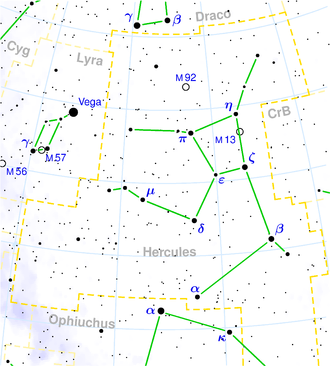NGC 6099
| Galaxy NGC 6099 |
|
|---|---|
![NGC 6099 (u) & NGC 6098 with LEDA 1593888 (lo) & LEDA 1592462 (lu) [1] SDSS image](https://upload.wikimedia.org/wikipedia/commons/thumb/4/45/NGC6099_-_SDSS_DR14.jpg/300px-NGC6099_-_SDSS_DR14.jpg)
|
|
| NGC 6099 (u) & NGC 6098 with LEDA 1593888 (lo) & LEDA 1592462 (lu) SDSS image | |
| AladinLite | |
| Constellation | Hercules |
|
Position equinox : J2000.0 , epoch : J2000.0 |
|
| Right ascension | 16 h 15 m 35.5 s |
| declination | + 19 ° 27 ′ 13 ″ |
| Appearance | |
| Morphological type | cD / E0 |
| Brightness (visual) | 14.2 mag |
| Brightness (B-band) | 15.2 mag |
| Angular expansion | 1.3 ′ × 1.3 ′ |
| Surface brightness | 14.8 mag / arcmin² |
| Physical data | |
| Affiliation | isolated |
| Redshift | 0.029817 ± 0.000033 |
| Radial velocity | (8939 ± 10) km / s |
|
Stroke distance v rad / H 0 |
(404 ± 28) x 10 6 ly (123.9 ± 8.7) Mpc |
| history | |
| discovery | Truman Safford |
| Discovery date | April 24, 1867 |
| Catalog names | |
| NGC 6099 • UGC 10299 N02 • PGC 57640 • CGCG 108-170 N02 • MCG + 03-41-146 • 2MASX J16153554 + 1927123 • VV 192a • GALEX ASC J161535.48 + 192711.5 • USGC U755 NED02 • KPG 493B | |
NGC 6099 is a 14.2 likes bright elliptical cD - radio galaxy from the Hubble type E0 in the constellation Hercules at the northern sky . It is an estimated 404 million light-years away from the Milky Way and about 155,000 light-years across. Together with NGC 6098 , it forms the gravitationally bound , isolated galaxy pair KPG 493 .
The object was discovered by Truman Safford on April 24, 1867 .
Web links
- NGC 6099. SIMBAD , accessed June 2, 2016 .
- NGC 6099. DSO Browser, accessed June 2, 2016 .
- Auke Slotegraaf : NGC 6099. Deep Sky Observer's Companion, accessed June 2, 2016 (English).
